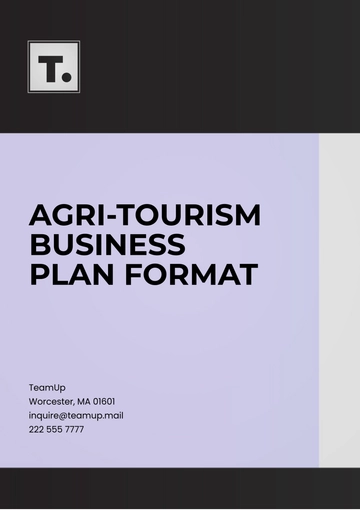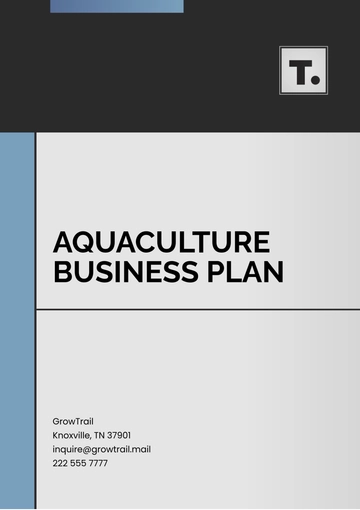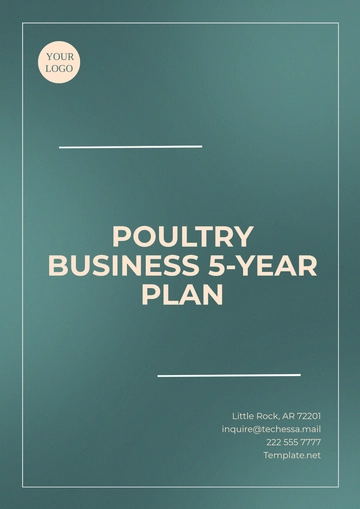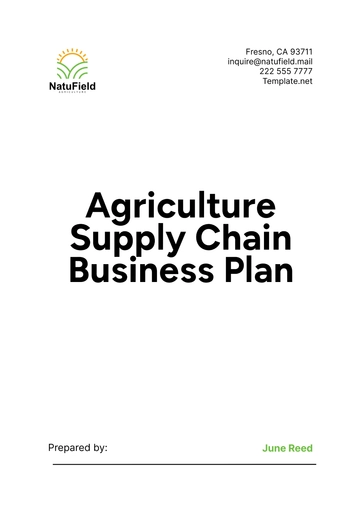Free Agricultural Business Plan

Prepared By: [Your Name] |
Company: [Your Company Name] |
Address: [Your Company Address] |
Website: [Your Company Website] |
Date: [Date] |
I. Executive Summary:
Our organic vegetable farm, [Your Company Name], aims to provide locally grown, sustainable produce to our community while promoting environmental stewardship and healthy living. With a focus on quality, innovation, and customer satisfaction, we seek to become a leading provider of fresh organic vegetables in the region.
II. Business Description:
[Your Company Name] will operate as a family-owned sole proprietorship, located on [Your Company Address] . Our farm will utilize organic farming methods to cultivate a variety of vegetables, including tomatoes, lettuce, carrots, peppers, and cucumbers. The farm will also include a small greenhouse for year-round production.
III. Market Analysis:
Our target market consists of health-conscious consumers, local restaurants, farmers' markets, and community-supported agriculture (CSA) programs. Market research indicates a growing demand for organic produce in our region, driven by increasing awareness of health and environmental issues.
IV. Products and Services:
[Your Company Name] will offer a diverse range of fresh organic vegetables, grown without synthetic pesticides or fertilizers. Our produce will be available for sale directly to consumers through farmers' markets, online sales platforms, and a CSA subscription program.
V. Marketing and Sales Strategy:
We will utilize a multi-channel marketing approach, including social media marketing, email newsletters, and partnerships with local restaurants and grocery stores. Additionally, we will participate in community events and farm-to-table dinners to promote our brand and connect with customers.
Social Media Marketing: Leveraging platforms like Facebook, Instagram, and Twitter to increase brand visibility, share content, and interact with the audience.
Email Newsletters: Providing subscribers with exclusive offers and valuable content to nurture leads and foster brand loyalty.
Partnerships with Local Businesses: Collaborating with local restaurants and stores to expand reach and position the brand as a trusted partner within the community.
Community Engagement:
Participation in Events: Engaging with consumers face-to-face at community events, health fairs, and farmers' markets.
Farm-to-Table Dinners: Hosting events to showcase the quality of products and commitment to sustainability.
Online Presence and Brand Building:
Website Optimization: Ensuring the website is user-friendly and optimized for search engines.
Content Creation: Creating valuable content like blog posts and recipe videos to resonate with the target audience.
Measurement and Optimization:
Performance Tracking: Monitoring marketing efforts and customer engagement through analytics tools and KPIs.
Continuous Improvement: Remaining agile and adapting strategies based on feedback and market trends to stay competitive.
VI. Operations Plan:
Our farm operations are designed to encompass a holistic approach, ensuring efficiency, sustainability, and productivity. We prioritize land preparation, planting, irrigation, pest control, and harvesting as integral components of our operational framework. Additionally, we are committed to implementing sustainable farming practices aimed at preserving and enhancing soil health and fertility.
Key Components:
Land Preparation: Prior to planting, meticulous land preparation is undertaken, encompassing soil testing, conditioning, and appropriate tillage practices to optimize soil structure and nutrient availability.
Planting: Thoughtful selection of crops and meticulous planting procedures are employed, taking into account soil conditions, climate patterns, and market demands. We prioritize diversity in crop selection to mitigate risks and maximize yields.
Irrigation: Our irrigation systems are carefully designed and managed to ensure optimal water distribution while minimizing waste. We leverage innovative techniques such as drip irrigation and rainwater harvesting to conserve water resources.
Pest Control: Integrated pest management (IPM) strategies form the cornerstone of our pest control approach. We emphasize preventive measures, biological controls, and judicious use of organic pesticides to maintain pest populations at manageable levels while minimizing environmental impact.
Harvesting: Timely and efficient harvesting practices are employed to maximize crop quality and yield. We utilize modern harvesting equipment and techniques to minimize losses and ensure product integrity.
Sustainable Farming Practices:
In line with our commitment to sustainability, we integrate the following practices into our operations:
Crop Rotation: We implement systematic crop rotation schedules to optimize soil health, reduce pest pressures, and enhance nutrient cycling.
Composting: Organic waste materials are carefully composted to produce nutrient-rich fertilizers, reducing the need for synthetic inputs and promoting soil fertility.
Cover Cropping: Cover crops are strategically planted to protect soil from erosion, suppress weeds, and improve soil structure, thereby enhancing long-term productivity and resilience.
Management Structure:
A dedicated team of skilled workers manages day-to-day operations under the guidance of the owner, who provides overarching leadership and strategic direction. Clear communication channels and regular training sessions ensure alignment with our operational objectives and values.
VII. Financial Plan:
Financial | |
|---|---|
Startup Costs | |
Land Acquisition | $300,000 |
Infrastructure Development | $150,000 |
Equipment Purchases | $200,000 |
Initial Operating Expenses | $100,000 |
Total Startup Costs | $750,000 |
Funding Strategy:
We plan to secure funding through a combination of personal investment, small business loans, and grants. This diverse approach will provide the necessary capital to cover our startup costs and initial operational expenses, ensuring a solid foundation for growth and sustainability.
Revenue Projections:
Our revenue projections are based on anticipated sales volume and pricing strategies. By leveraging market research and industry trends, we aim to establish competitive pricing while maintaining profitability. The focus is on achieving financial stability and growth within the first three years of operation.
Key Financial Goals:
Achieve profitability within the first three years.
Maintain healthy cash flow to support ongoing operations and future expansion.
Establish reserves for unforeseen expenses and market fluctuations.
VIII. Risk Management:
Key Risks:
Adverse Weather Conditions
Pest Infestations
Market Competition
Regulatory Compliance Issues
Risk Mitigation Strategies:
Crop Diversification: By cultivating a variety of crops, we reduce the impact of adverse weather conditions and pest infestations on our overall yield and revenue.
Insurance Coverage: We will invest in comprehensive insurance policies to protect our farm against potential losses due to weather-related damage, crop failure, and other unforeseen events.
Ongoing Monitoring: Regular monitoring of market trends and regulatory changes allows us to adapt our strategies in response to evolving conditions, ensuring compliance with relevant laws and regulations while staying competitive in the marketplace.
IX. Implementation Timeline:
Implementation Timeline | Activities |
|---|---|
Month 1-3 | Land acquisition and infrastructure development |
Month 4-6 | Soil preparation and planting of initial crops |
Month 7-9 | Implementation of marketing and sales strategy |
Month 10-12 | Expansion of production and distribution channels |
Month 1-3: Land acquisition and infrastructure development
Month 4-6: Soil preparation and planting of initial crops
Month 7-9: Implementation of marketing and sales strategy
Month 10-12: Expansion of production and distribution channels
- 100% Customizable, free editor
- Access 1 Million+ Templates, photo’s & graphics
- Download or share as a template
- Click and replace photos, graphics, text, backgrounds
- Resize, crop, AI write & more
- Access advanced editor
Maximize your farming venture's success with the customizable Agricultural Business Plan Template offered by Template.net. This downloadable and printable template is designed to streamline your planning process, ensuring comprehensive coverage of all critical areas. Effortlessly editable in our AI Editor Tool, this template allows you to tailor every detail to your specific needs, paving the way for a prosperous agricultural business.
You may also like
- One Page Business Plan
- Coffee Shop Business Plan
- Restaurant Business Plan
- Food Business Plan
- Real Estate Business Plan
- Executive Summary Business Plan
- Cover Page Business Plan
- Nonprofit Business Plan
- Daycare Business Plan
- Construction Business Plan
- Startup Business Plan
- Medical Business Plan
- Bakery Business Plan
- Service Plan
- Hotel Business Plan
- Catering Business Plan
- School Business Plan
- Healthcare Business Plan
- Transportation Plan
- Sports Plan
- Car Wash Business Plan
- Salon Business Plan
- Clothing Business Plan
- Farming Business Plan
- Boutique Plan





























